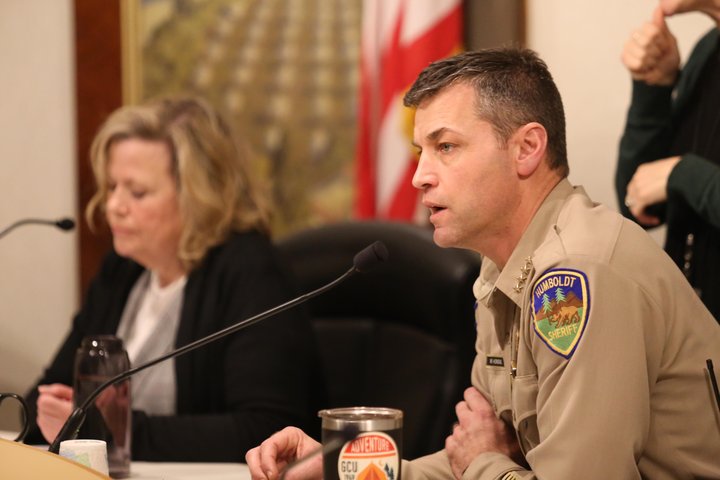
Dr. Teresa Franovich and Sheriff Billy Honsal at today’s press conference announcing the shelter-in-place order. For video of the press conference, click here. Photo: Andrew Goff.
###
As you probably know, Humboldt County has issued a “shelter-in-place order” in an effort to slow the spread of the COVID-19 virus in Humboldt County (or to Humboldt County, if it’s not here yet). The order takes effect tonight at midnight and lasts until at least April 9 — the next three weeks.
This is a legal order. If you violate it, you break the law. Police will have the authority to arrest you and charge you with a misdemeanor if you’re found in violation of the order – not that they’re looking to do that.
“We are about educating, not enforcement,” said Sheriff Billy Honsal at the press conference earlier today. “Our goal is to achieve compliance through education. The last thing we want to do is cite someone or arrest someone.”
But what, exactly, is the shelter-in-place order? Here’s an overview of what it says. If you have questions or need more detail, definitely check the document itself, which you can find here in PDF form.
Basically, the rule of thumb – with a few exceptions – is that people are to stay in their home with their families, or the regular members of their household.
That means that all businesses are to close, with the exception of “essential businesses.” All gatherings of any size, outside the people you’re sheltering with, are prohibited. You’re not supposed to travel – by foot, bike, car, public transportation or otherwise – unless it’s to perform an “essential activity.”
What are “essential activities”? You can read a whole list of them in the order, but they’re more broad than you might think. They include:
- Shopping for food, medicine, medical supplies, and items need to work from home, for you and the members of your household.
- To go to the doctor or the hospital, or to take your pet to the vet.
- To care for a family member in another household.
- To go to work, if you work for an “essential company” or work maintaining “essential infrastructure.”
- To exercise outside. Yes – you can still walk, hike, bike, run, etc. – just don’t use playground equipment, and continue to maintain 6 feet of distance between yourself and others.
What are the “essential businesses”? Who’s still going to be open?
- Grocery stores, pharmacies, banks, gas stations, hardware stores and laundromats.
- Restaurants doing takeout or delivery only.
- Businesses that supply products needed to work from home.
- “Businesses that supply products which would enhance the quality of life,” can also remain open, but the quality-of-life goods may only be sold “in a way that prevents handling by the customer prior to purchase” – for example, the order says, through curbside pickup.
Agriculture, including cannabis agriculture, is considered an “essential business” as well, as are electricians, plumbers and other tradesmen. The media – newspapers, radio, TV, and “other media services” are also considered essential.
In addition, of course, police, firefighters, doctors, nurses, paramedics, care home workers and in-home care providers, as well as the people who support their work, will continue to work. So will people who maintain roads, sewage systems, garbage collection, the supply of water and electricity and the Internet. These all fall under the heading of “critical infrastructure.”
But the basic rules – always, under any circumstance – are to always maintain six feet of distance between yourself and anyone who you’re not sheltering with, washing hands frequently with soap for more than 20 seconds, covering coughs with your elbow or sleeve, cleaning and disinfecting surfaces regularly, and not shaking hands.
That’s the overview. There are other exceptions and special cases that might be of interest to some, but that should cover most of your circumstances. Again – if you need more detail, check the document itself, which can be found at this link.
###
PREVIOUSLY:
CLICK TO MANAGE